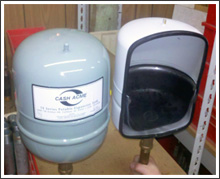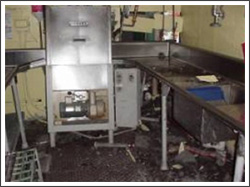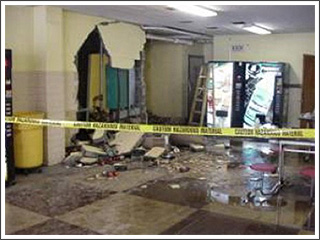Expansion Tanks
An expansion tank or expansion vessel is a small tank used to protect closed water heating systems and domestic hot water systems from excessive pressure. The tank is partially filled with air, whose compressibility cushions shock caused by water hammer and absorbs excess water pressure caused by thermal expansion.
 The modern vessel is a small container divided in two by a rubber diaphragm. One side is connected to the pipe work of the heating system and therefore contains water. The other, the dry side, contains air under pressure, and normally a Schrader valve (car-tire type valve stem) for checking pressures and adding air. When the heating system is empty or at the low end of the normal range of working pressure the diaphragm will be pushed against the water inlet. As the water pressure increases, the diaphragm moves, compressing the air on its other side. An older style of expansion tank is larger, oriented horizontally, and has no rubber diaphragm.
The modern vessel is a small container divided in two by a rubber diaphragm. One side is connected to the pipe work of the heating system and therefore contains water. The other, the dry side, contains air under pressure, and normally a Schrader valve (car-tire type valve stem) for checking pressures and adding air. When the heating system is empty or at the low end of the normal range of working pressure the diaphragm will be pushed against the water inlet. As the water pressure increases, the diaphragm moves, compressing the air on its other side. An older style of expansion tank is larger, oriented horizontally, and has no rubber diaphragm.
When expansion tanks are used in domestic hot water systems, the tank and the diaphragm must conform to drinking water regulations and must be capable of accommodating the required volume of water. In the past, domestic plumbing systems often contained more air than they do currently. Thus, expansion tanks are now used more frequently than in the past.
Having the right expansion tank is critically important to protect the safety of your building and the people who live and work there. Today’s plumbing codes require that thermal expansion control be addressed.
Temperature and Pressure Relief Valves
Most commercial consumers take for granted their hot water supply and rarely think about their water heaters once they have been installed. Where water heaters are concerned, “out of sight” is usually “out of mind.” and to date, many are unaware of the need to have their water heaters regularly maintained to prevent water heater explosions.
 The Temperature and pressure relief valve (T & P) is the primary “back-up” safety measure which prevents the water in the pressurized hot water cylinder from overheating. An explosion of a water heater presumes at least two system failures. Generally, the safety mechanism in the controls, coupled with a properly installed and working T & P relief valve and thermal expansion tank, insures a safe system.
The Temperature and pressure relief valve (T & P) is the primary “back-up” safety measure which prevents the water in the pressurized hot water cylinder from overheating. An explosion of a water heater presumes at least two system failures. Generally, the safety mechanism in the controls, coupled with a properly installed and working T & P relief valve and thermal expansion tank, insures a safe system.
There have been instances where inadequate protection became deadly. In March of 2000, a five gallon water heater exploded in an elementary school in Avon Massachusetts killing two and injuring 36. In addition the school suffered significant damage as you can see in the pictures below.
 The report back from the National Board testing lab conclusively determined that the pressure temperature valve failed to operate and did not prevent the temperature of the vessel from reaching 212 F. In order for the vessel to fail catastrophically with force sufficient to cause the building structural damage, the temperature of the water in the vessel had to be over 212 F in order for the water to flash into steam.
The report back from the National Board testing lab conclusively determined that the pressure temperature valve failed to operate and did not prevent the temperature of the vessel from reaching 212 F. In order for the vessel to fail catastrophically with force sufficient to cause the building structural damage, the temperature of the water in the vessel had to be over 212 F in order for the water to flash into steam.
At Lima Company, we have the experience and knowledge to make your hot water system safe. Don’t take a chance on your safety.
* The notice below is a warning directly out of a commercial water heater, Operations Manual.
